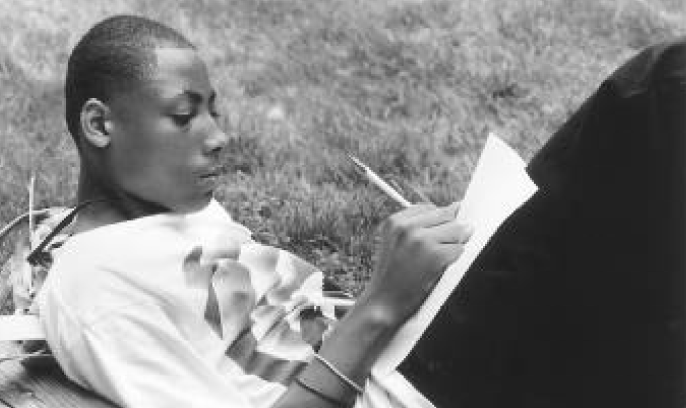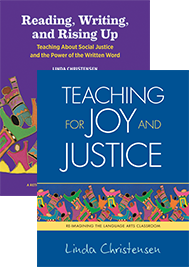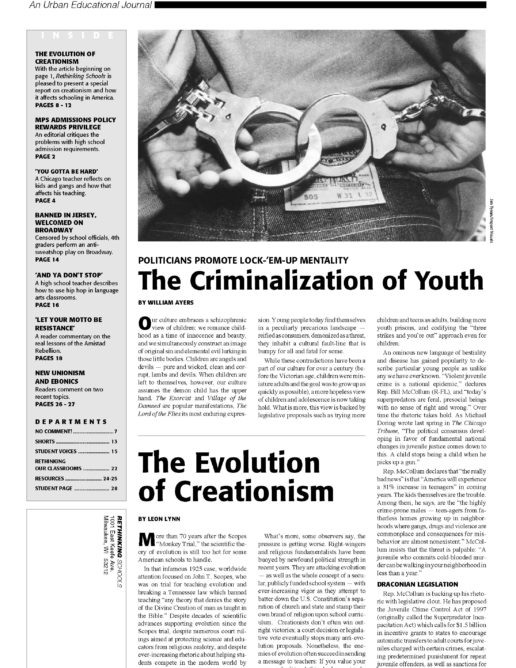Where I’m From
INVITING STUDENT LIVES INTO THE CLASSROOM

I remember holding my father’s hand as he read my story hanging on the display wall outside Mrs. Martin’s classroom on the night of Open House. I remember the sound of change jingling in Dad’s pocket, his laughter as he called my mom over and read out loud the part where I’d named the cow “Lena” after my mother and the chicken “Walt” after my father. It was a moment of sweet joy for me when my two worlds of home and school bumped together in a harmony of reading, writing, and laughter.
In my junior year of high school, I skipped most of my classes, but crawled back through the courtyard window of my English class where Ms. Carr selected novels and volumes of poetry for me to read, where she wrote notes in the margins of my papers asking me questions about my home, my mother, my sister who’d run away, my father who’d died three years before, instead of responding by correcting my errors like my other teachers.
These two events from my schooling capture part of what the editors of Rethinking Our Classrooms meant when we encouraged teachers to make students feel “significant” in our classrooms:
The ways we organize classroom life should seek to make children feel significant and cared about — by the teacher and by each other. Unless students feel emotionally and physically safe, they won’t share real thoughts and feelings. Discussions will be tinny and dishonest. We need to design activities where students learn to trust and care for each other. Classroom life should, to the greatest extent possible, prefigure the kind of democratic and just society we envision and thus contribute to building that society. Together students and teachers can create a “community of conscience,” as educators Asa Hillard and George Pine call it (p. 4).
Mrs. Martin and Ms. Carr made me feel significant and cared about because they invited my home into the classroom. When I wrote and included details about my family, they listened. They made space for me and my people in the curriculum.
Today in my classroom at Jefferson High School, I attempt to find ways to make students feel significant and cared about as well, to find space for their lives to become part of the curriculum. I do this by inviting them to write about their lives, about the worlds from which they come. Our sharing is one of the many ways we begin to build community together. It “prefigures” a world where students can hear the home language from Diovana’s Pacific Islander heritage, Lurdes’ Mexican family, Oretha’s African-American home, and my Norwegian roots and celebrate without mockery the similarities as well as the differences.
Sometimes grounding lessons in students’ lives can take a more critical role by asking them to examine how they have been shaped or manipulated by the media, for example. But as critical teachers, we shouldn’t overlook the necessity of connecting students around moments of joy as well.
This year I found a poem in The United States of Poetry 1 that I used to invite my students’ families, homes, and neighborhoods into the classroom. It’s called “Where I’m From” by George Ella Lyon. Lyon’s poem follows a repeating pattern “I am from…” that recalls details, evokes memories – and can prompt some excellent poetry.
Lyon’s poem allowed me to teach about the use of specifics in poetry and in writing in general. But the lesson also brought the class together through the sharing of details from our lives and lots of laughter and talk about the “old ones” whose language and ways continue to permeate the ways we do things today.
Where I‘m From
I am from clothespins,
George Ella Lyon
from Clorox and carbon-tetrachloride.
I am from the dirt under the back porch.
(Black, glistening it tasted like beets.)
I am from the forsythia bush, the Dutch elm
whose long gone limbs I remember as if they were my own.
I am from fudge and eyeglasses, from Imogene and Alafair.
I’m from the know-it-alls and the pass-it-ons,
from perk up and pipe down.
I’m from He restoreth my soul with a cottonball lamb
and ten verses I can say myself.
I’m from Artemus and Billie’s Branch, fried corn and strong coffee.
From the finger my grandfather lost to the auger
the eye my father shut to keep his sight.
Under my bed was a dress box spilling old pictures,
a sift of lost faces
to drift beneath my dreams.
I am from those moments — snapped before I budded — leaf-fall from the family tree.
TEACHING PROCEDURE:
- After the students read the poem out loud together, we note that Lyon begins many of her lines with the phrase, “I am from.” I remind the class of William Stafford’s 2 advice to find a hook to “link the poem forward” through some kind of device like a repeating line, so the poem can develop a momentum. I suggest they might want to use the line “I am from” or create another phrase that will move the poem.
- We go line by line through the poem and notice the details Lyon remembers about her past. After we read, I ask students to write lists that match the ones in Lyon’s poem and to share them out loud. This verbal sharing sparks memories to bubble up from student to student and also gives us memories to share as we make our way through the lesson:
Items found around their home: bobby pins or stacks of newspapers, grandma’s teeth, discount coupons for a Mercedes. (They don’t have to tell the truth.)
Items found in their yard: broken rakes, dog bones, hoses coiled like green snakes. (I encourage them to think of comparisons as they list.)
Items found in their neighborhood: the corner grocery, Mr. Tate’s beat up Ford Fairlane, the “home base” plum tree.
Names of relatives, especially ones that link them to the past: Uncle Einar and Aunt Eva, Claude, the Christensen branch.
Sayings: “If I’ve told you once…” (The students had a great time with this one; they had a ready supply that either brought me back to childhood or made me want to steal their families’ lines.)
Names of foods and dishes that recall family gatherings: ludefisk or tamales or black eyed peas.
Names of places they keep their childhood memories: Diaries, boxes, underwear drawers, inside the family Bible. - We share their lists out loud as we brainstorm. I encourage them to make their piece “sound like home,” using the names and language of their home, their family, their neighborhood. The students who write vague nouns like “shoes” or “magazines,” get more specific when they hear their classmates shout out, “Jet,” “Latina,” “pink tights crusted with rosin.” Out of the chaos, the sounds, smells, and languages of my students’ homes emerge in poetry.
- Once they have their lists of specific words, phrases, and names, I ask them to write. I encourage them to find some kind of link or phrase like “I am from..” to weave the poem together and to end the poem with a line or two that ties their present to their past, their family history. For example, in Lyon’s poem, she ends with “Under my bed was a dress box / spilling old pictures… . I am from those moments… .”
- After students have written a draft, we “read around.” This is an opportunity for students to feel “significant and cared about” as they share their poems. But as most teachers know, students don’t automatically give their undivided attention to each other when they share pieces in the class. To facilitate the process and to make sure that students get the attention their pieces deserve, I have students write comments about each reader’s piece. I do this to keep them focused on the reader, but it’s also a way for them to learn from each other what makes good writing. I tell them, “Pull out a piece of paper. Write the name of the reader, then as each person reads, write what you liked about their piece. Be specific, write down what words or phrases made the piece work. Did they use a list? A metaphor? Humor?”
- Seated in our circle, each student reads his/her poem. After the student reads, classmates raise their hands to comment on what they like about the piece. The writer calls on his/her classmates and receives feedback about what is good in the poem. I rarely comment during this process because students pick up on all of the points I would have made. I do stop from time to time to point out that the use of a list is a technique they might “borrow” from their peer’s poem and include in their next poem or in a revision; I might note that the use of Spanish or home language adds authenticity to a piece and ask them to see if they could add some to their piece. After a few read-around sessions I can spot writing techniques that students have “borrowed” from each other and included in their revisions or in their next piece: Dialogue, church sayings, lists, exaggeration.
The following excerpts are from student poems that Lyon’s piece provoked:
Oretha Storey
I am from bobby pins, doo rags, and wide tooth combs.
I am from prayer plants that lift their stems
and rejoice every night.
I am from chocolate cakes and deviled eggs
from older cousins and hand-me-downs to “shut ups” and “sit downs”
I am from Genesis to Exodus, Leviticus, too.
church to church, pew to pew
I am from a huge family tree that begins with dust
and ends with me.
I am from old pictures and hand sewn quilts.
Lurdes Sandoval
I am from the Yerba Buena
to the old walnut tree that is no more.
I am from carne con chile
to queso con tortillas.
I am from farmers and ancient Indians
to the frijoles and sopa
they ate.
I am from awapuhi ginger, sweet fields of sugar cane, green bananas.
Djamila Moore
I am from warm rain cascading over taro leaf umbrellas,
crouching beneath the shield of kalo.
I am from poke, brie cheese, mango, and raspberries,
from Maruitte and Aunty Nani.
I am from Moore and Cackley from sardines and haupia.
From Mirana’s lip Djavan split to the shrunken belly
my grandmother could not cure.
I am from Aztlan
Alejandro Vidales
where many battles and wars were fought.
I am from the strength and courage of the Aztecs
who died for our freedom.
I am from traditions and customs from posadas and quinceñeras
to día del a muerte and buena suerte.
I am from the blood of my ancestors, the dreams of my grandmother,
the faith of my mother,
and the pride of my culture. I am from the survivors.
I am from the land that struggles for freedom.
Cang Dao
I am from the rice field, water buffaloes and cows.
I am from the place where Blood floats like rivers.
Innocent souls are trapped under the ground.
Dead bodies haven’t yet been buried.
A beautiful barn becomes a cemetery.
It wasn’t supposed to be like this.
I am from the place I hold now only as a memory.
I am from a family with hearts like stones.
“Where I’m From” is one tiny lesson in a year of critical teaching. But as we create schools and classrooms that are “laboratories for a more just society than the one we now live in,” we need to remember to make our students feel significant and cared about. But these kinds of lessons keep me going, too. When the gray days of budget cuts, standardized tests, school restructuring plans gone awry, and bad teacher room talk pile up one after another like layers of old newspapers on your back porch, pull out George Ella Lyon’s poem and invite the stories and voices of your students into the classroom.


